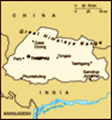Advertisement

 New friends
New friends
Students who joined us at dinner. Dig the outfits!Traveling the countryside of Bhutan
We left Thimphu for the former capital city of Punakha and some traveling through the countryside.
Before departing we enjoyed a dinner with some high school students and were dressed in the national dress, a gho for George and a kira for Marcia. It took two hotel staff to dress us, even though the kids we had dinner with claimed that by age 12 they could put on the clothes by themselves.
While driving through the countryside we got a taste of the fourth pillar of 'gross national happiness', good governance. Bhutan is a monarchy, now under the rule of its fifth king. It was a state back in the 1600s, but civil wars tore it apart in the 1700s and it was only unified again near the end of the 1800s. At that time the country voted to have a king, feeling that only a strong central government would prevent deterioration into warfare again. In 1907 the first king was elected, he was the head of the strong central state that had pulled the nation back together.
The kings are beloved figures here. The first king is revered as the monarchy

 Punakha Dzong
Punakha Dzong
Where brown trout filled the river.king, the second as the consolidator, the third as the Father of Modern Bhutan as he opened the country and oversaw the building of the infrastructure. The fourth king, still alive, is known as the visionary king as he created a constitutional monarchy which limited holding public office to those under the age of 65, including the king, thus he abdicated in favor of his son. And the current king is known as the People's King as he has started them on the road to gross national happiness.
In past blogs I have mentioned the reforms, such as health care and education. There are also equal rights and land rights. Women were granted equal status with men in hiring, holding government office, wages, etc. in the 1960s (about the time the US was busy turning down the Equal Rights Amendment to our constitution). But wait, only a son can be the king--not totally equal. In terms of land, there was a type of serfdom here, with landless people working for landholders, sharecropping if you will. To deal with this, the king decreed that no one could hold more than 35 acres privately, and redistributed the remaining land to farmers.

 Yak Herder flirts with Marcia
Yak Herder flirts with Marcia
One of the traditional dancers entices Marcia to a life herding yaks.Now, no one is unemployed or homeless.
Good governance here does impinge on one type of freedom, freedom from restraint. As the government does restrain how much people can own and restrains you from discriminating against women. However, that creates another freedom, freedom to do. As everyone has a job, or land, or the right to be treated equally. It is an interesting balancing act watched over by a monarch that keeps giving away his power.
We also were served a heaping serving of local culture. We visited Punakha Dzong, the fortress where it all started that straddles two rivers full of trout. (I fed them holy bread from the ceremony we attended, I have never seen that many big trout in one place...they are happy Buddhists don't kill fish--or fish for that matter.) While there we happened into the temple where 150 monks were holding a prayer service, complete with horns, drums and chants--it was heavenly.
We also visited the Temple of the Divine Madman--a Buddhist priest who wanted people to enjoy life and enjoyed wine and women himself. In fact, he was know to (OK time for those under 18 to stop reading) repel demons
with his penis and you will find phallic symbols painted on walls and carved phalluses hanging from roofs to protect the household. Yes, there was even a Phallus Bar at our hotel.
Traveling through the countryside we watched as small fields were prepared by hand for the soon to come rice planting and the winter wheat was harvested, also by hand. We also stopped at the Dochhula Pass at 10,000 feet and viewed the Himalayas. Including the highest unclimbed mountain in the world as the Bhutan government refuses to allow climbers due to all the trash they leave (a massive problem on Everest).
We finished today with two cultural events. The first was a visit to a 300 year old farm still operated by the same family, the young man who showed us around was a member of the 12 generation on the land. We were shown through the home, served a traditional dinner--including more chili cheese--and then settled in for a real treat. We were provided an hour dance production put on by 8 local dancers and including music and dance from all regions of the country. Marcia was especially charmed by the yak herder in his

 Ringing the gong
Ringing the gong
To conclude the prayer ceremonydance! We joined hands for a farewell dance and no one wanted to leave.
Finally, at our hotel, our guides gave us an archery demonstration using traditional bows and arrows and George, on the last attempt by the group, was able to hit the target! As with a hole in one, tonight he buys the drinks.
Advertisement
Tot: 0.24s; Tpl: 0.015s; cc: 18; qc: 64; dbt: 0.0849s; 1; m:domysql w:travelblog (10.17.0.13); sld: 1;
; mem: 1.2mb















